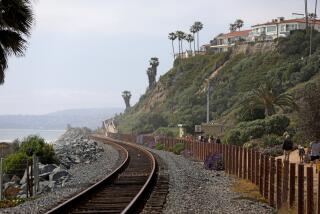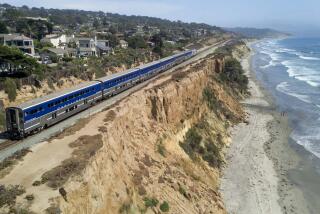Kwai Railway Tourist Rides? Ex-POWs Angry
BANGKOK, Thailand — Over jungled ridges and along malarial rivers, the track of the “Death Railway” stretched for more than 250 miles, each the last mile for some of the estimated 16,000 Allied prisoners of war and 100,000 Asian laborers who died building it.
Now, in a move that has revived bitter wartime memories, the Thai government is considering restoring an unused part of the line, for tourists, and using a Japanese engineering firm on the job.
“It’s as if Auschwitz were to be reopened as an amusement park,” a shocked Dutch survivor of the World War II project said.
Australian Outraged
The head of an Australian veterans’ organization called the plan “outrageous.” He said that if Japanese are involved in the restoration, “I hope that former prisoners of war are there to supervise it.”
As the controversy flared this week, Thai and Japanese authorities became cautious and defensive, even though the project may never get beyond the talking stage. State railway officials said Friday that the restoration project may be shelved indefinitely--not because of any moral considerations but because there is no money for it.
Niyom Niyamanusorn, an official of the Thai Public Works Department, objected to comparing the railway project with an amusement park.
“Children and grandchildren of Allied prisoners and laborers can appreciate the scenic beauty of the jungle . . . rather than wallow in sorrow,” he said, then added in apparent contradiction, “If we don’t reopen the death railway now, people will forget the wartime atrocities sooner.”
No Japanese Position
A feasibility study has been done by a Japanese consulting firm, but a spokesman for the Japanese Embassy, Masato Kakami, said Tokyo has “no official view” on the proposal.
“This is a sensitive issue with some countries, namely Australia, the Netherlands and others,” Makami said. “If the Thai government decided to go ahead with the project, we would be more inclined to support it.”
It is not clear who raised the idea. A spokesman for the state railway system said the Japanese firm, the Chiyoda Consultant Co., had put the plan to provincial authorities in Kanchaniburi, northwest of Bangkok.
Part of the railway has long been a tourist attraction. It runs from Bangkok through Kanchaniburi province and over the Kwai River. It is this section that was memorialized in the 1957 film “The Bridge on the River Kwai.”
Shrine of Atonement
Takashi Nagase, 69, who was a military policeman on the project, said in Tokyo, “The Japanese forget the past easily, but Australians and the Dutch will never forget the hardship.” Last year Nagase traveled to the crossing on the Kwai to erect a shrine of atonement.
The railway was begun in early 1942, designed to supply Japanese forces in Burma from a railhead in Bangkok. Before the war, European engineers had studied a route across the terrain, so rugged that few Thais or Burmese lived in the area. It could be done, the Europeans decided, but not economically.
Wartime demands changed the situation. Japanese shipping direct to Rangoon, Burma, was subject to Allied submarine and air attack, so the Japanese ordered a rail line built from a point west of Bangkok through the jungle to Three Pagodas Pass on the Burmese border, then on to connect with the Burmese rail system at the old port of Moulmein.
The labor problem was solved by rounding up Allied servicemen captured in the first months of the war and held in prison camps in Java, Sumatra, Singapore and Malaya. They were taken by train from Singapore to Thailand, a five-day trip in steel boxcars. Some POWs, who had been held in Singapore’s notorious Changi Prison, looked forward to the change, thinking that the food at least might be better.
Brutal Conditions
In all, 61,000 prisoners of war, including some Americans, and more than a quarter of a million Asian laborers worked on the railway, which was completed in October of 1943. Conditions were brutal and the Japanese soldiers pitiless, according to survivor accounts.
Many died of starvation, disease or maltreatment. Some were executed. Escape was meaningless; the nearest Allied lines were 1,000 miles away.
A British survivor, Russell Bradden, remarked that mention of the railway calls up memories “of monsoons and malaria, of bamboo and bashings, of cholera and corpses.”
More to Read
Sign up for Essential California
The most important California stories and recommendations in your inbox every morning.
You may occasionally receive promotional content from the Los Angeles Times.










